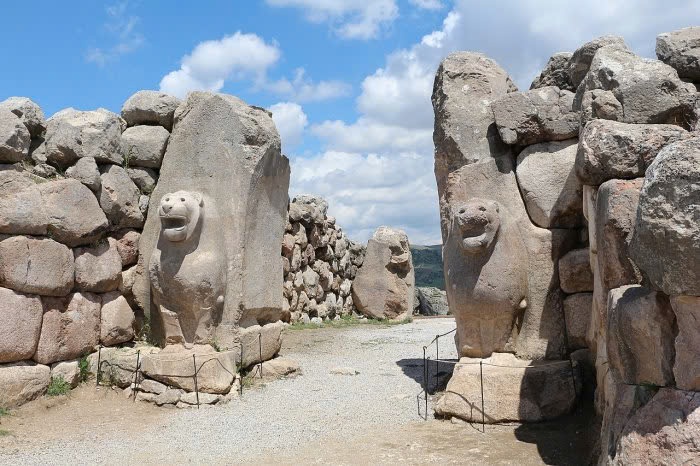Nestled among the rugged, rocky outcrops near the ancient Hittite capital of Hattusha lies a remarkable open-air sanctuary known as Yazılıkaya. This sacred site, whose name means “inscribed rock” in Turkish, offers a captivating glimpse into the spiritual world of the once-dominant Hittite Empire. With its intricate bas-reliefs depicting a grand procession of Hittite deities, Yazılıkaya stands as a testament to the artistic and religious achievements of this ancient Anatolian civilization.
In this blog post, we’ll delve into the fascinating history and significance of Yazılıkaya, exploring how this remarkable site provides a window into the Hittites’ cosmological beliefs, royal power, and cultural influences. From the awe-inspiring divine procession to the site’s role in Hittite New Year celebrations, we’ll uncover the layers of meaning and symbolism that make Yazılıkaya such a remarkable and enigmatic archaeological treasure.
The Divine Procession

As worshippers entered the Yazılıkaya sanctuary, they were greeted by an awe-inspiring sight: the walls adorned with intricate bas-reliefs depicting a grand procession of Hittite deities. Arranged in two long lines converging at the center, these gods and goddesses, their heads crowned with pointed caps or elaborate tiaras, marched with a sense of power and majesty.
At the heart of this divine procession stood the mighty weather god Teshub, revered as the “King of Heaven, Lord of The Land of the Hatti.” Facing him was his divine consort, a testament to the importance of the sacred union between the male and female principles in Hittite cosmology.
A Pantheon Revealed
While many of the figures in the Yazılıkaya reliefs remain unidentified, archaeologists have been able to recognize several key deities within the procession. Among them is Sharruma, the son of the great gods, leading the procession of goddesses. Shaushga, the Hittite version of the goddess Venus, marches alongside the male gods, reflecting the central role of female deities in the Hittite pantheon.

Another prominent figure is Telipinu, the patron god of vegetation, who is depicted holding symbols of abundance – a testament to the Hittites’ reverence for the natural world and the cycle of growth and renewal.
Intriguingly, the hieroglyphic inscriptions accompanying these gods bear Hurrian names, underscoring the complex cultural influences that shaped Hittite religion. The Hittites, known for their ability to assimilate and adapt the beliefs of neighboring civilizations, seamlessly incorporated Hurrian deities and traditions into their own spiritual practices.
A Royal Legacy
The creation of Yazılıkaya is closely tied to the Hittite royal family and their efforts to solidify their divine right to rule. King Hattushili III and his son Tudhaliya IV commissioned the carving of these magnificent sculptures in the 13th century BCE, during a period of Hittite cultural and political resurgence.

Queen Puduhepa, a priestess from the Hurrian province of Kizzuwatna, played a crucial role in this process. Her influence helped bring new religious traditions and practices to the Hittite court, further enriching the cultural tapestry of the empire.
Celebrating the Cosmic Order
Yazılıkaya was more than just a beautiful monument; it served as a sacred site for the Hittites to celebrate the union of Heaven and Earth at the New Year. Ancient texts suggest that this springtime festival, possibly coinciding with the vernal equinox, was a time to reaffirm the cosmic order and the Hittite king’s divine right to rule.

Through this annual celebration, the Hittites sought to maintain the delicate balance between the celestial and earthly realms, ensuring the continued prosperity and stability of their empire. The grand procession of deities carved into the Yazılıkaya sanctuary likely played a central role in these rituals, serving as a tangible representation of the divine forces that governed the Hittite world.
A Window to the Past
Today, Yazılıkaya stands as a testament to the artistic and spiritual achievements of the Hittite civilization. Its weathered yet still impressive reliefs continue to captivate visitors, offering a unique window into the religious beliefs, royal power, and cultural sophistication of this ancient Anatolian empire
.
As we gaze upon the intricate carvings and hieroglyphic inscriptions, we are transported back in time, gaining a deeper understanding of the Hittites’ cosmological worldview and the central role that their deities played in shaping their society. Yazılıkaya’s enduring legacy serves as a powerful reminder of the rich cultural heritage that lies buried beneath the sands of Anatolia, waiting to be rediscovered and celebrated.
Conclusion
The Yazılıkaya sanctuary is a true marvel of the ancient world, a sacred site that continues to captivate and inspire scholars and visitors alike. Through its magnificent bas-reliefs and the stories they tell, we gain a profound appreciation for the artistic, religious, and political achievements of the Hittite Empire – a civilization that once dominated much of Anatolia but whose legacy has long been obscured by the mists of time.
As we explore the wonders of Yazılıkaya, we are reminded of the enduring power of human creativity and the deep-rooted spiritual beliefs that have shaped the course of history. This remarkable site stands as a testament to the resilience of the human spirit and the timeless allure of the sacred, inviting us to connect with the rich tapestry of our shared past.

